Training and Development Environment Analysis for Commonwealth Bank
VerifiedAdded on 2021/05/31
|17
|3219
|22
Report
AI Summary
This report provides an in-depth analysis of the training and development needs assessment conducted for the Australian Commonwealth Bank. It begins by defining training and development and highlighting its benefits, such as improved productivity, reduced supervision, and increased employee satisfaction. The report then details the methods employed for the needs assessment, including the use of questionnaires and interviews at various management levels. It further evaluates the needs assessment process, referencing Kirkpatrick's levels of evaluation to determine the effectiveness of the training programs. The report also explores the potential negative outcomes if the needs assessment is poorly planned or conducted, such as high employee turnover and poor resource utilization. Overall, the report emphasizes the importance of a well-structured training and development program for bridging performance gaps and achieving organizational goals within the Commonwealth Bank, supported by relevant research and data.
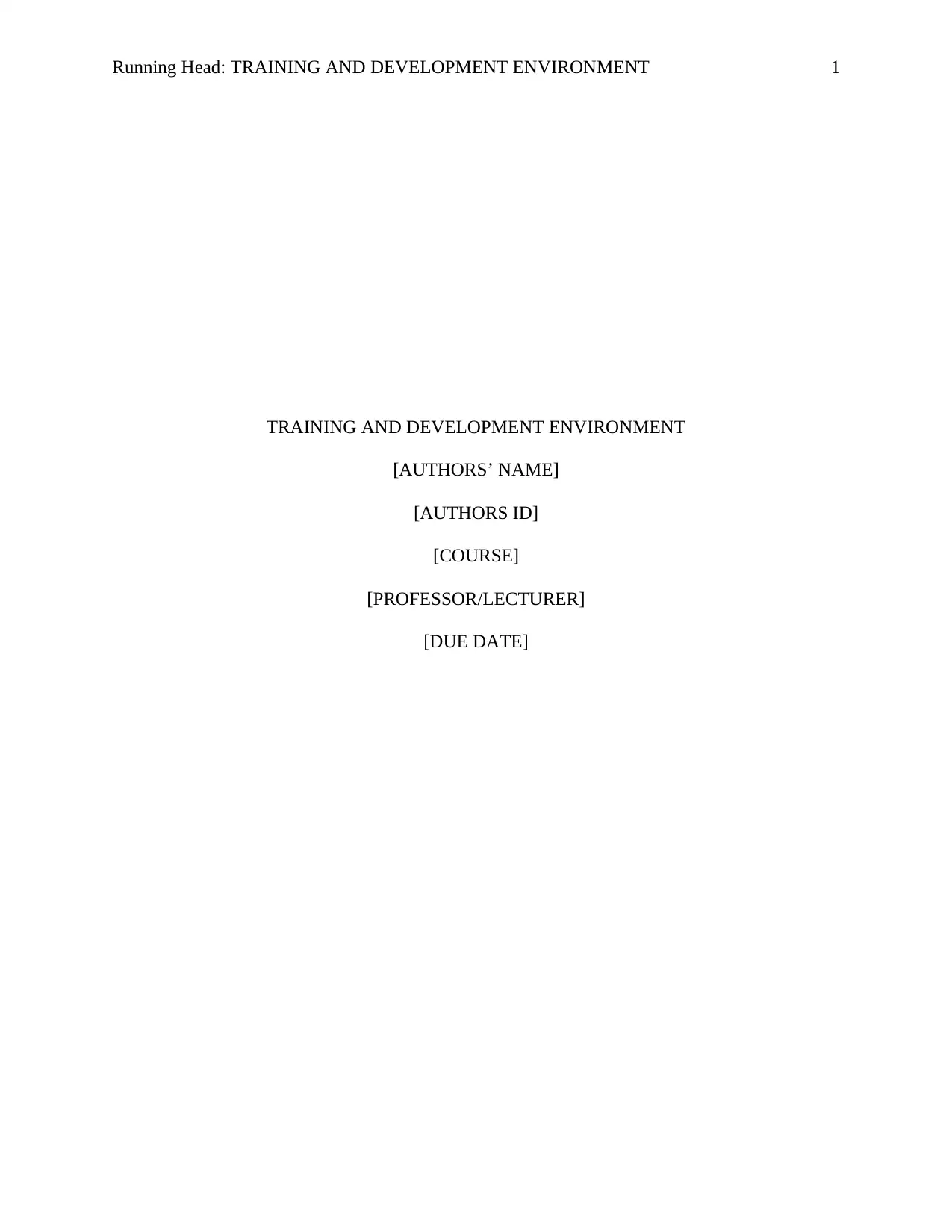
Running Head: TRAINING AND DEVELOPMENT ENVIRONMENT 1
TRAINING AND DEVELOPMENT ENVIRONMENT
[AUTHORS’ NAME]
[AUTHORS ID]
[COURSE]
[PROFESSOR/LECTURER]
[DUE DATE]
TRAINING AND DEVELOPMENT ENVIRONMENT
[AUTHORS’ NAME]
[AUTHORS ID]
[COURSE]
[PROFESSOR/LECTURER]
[DUE DATE]
Paraphrase This Document
Need a fresh take? Get an instant paraphrase of this document with our AI Paraphraser
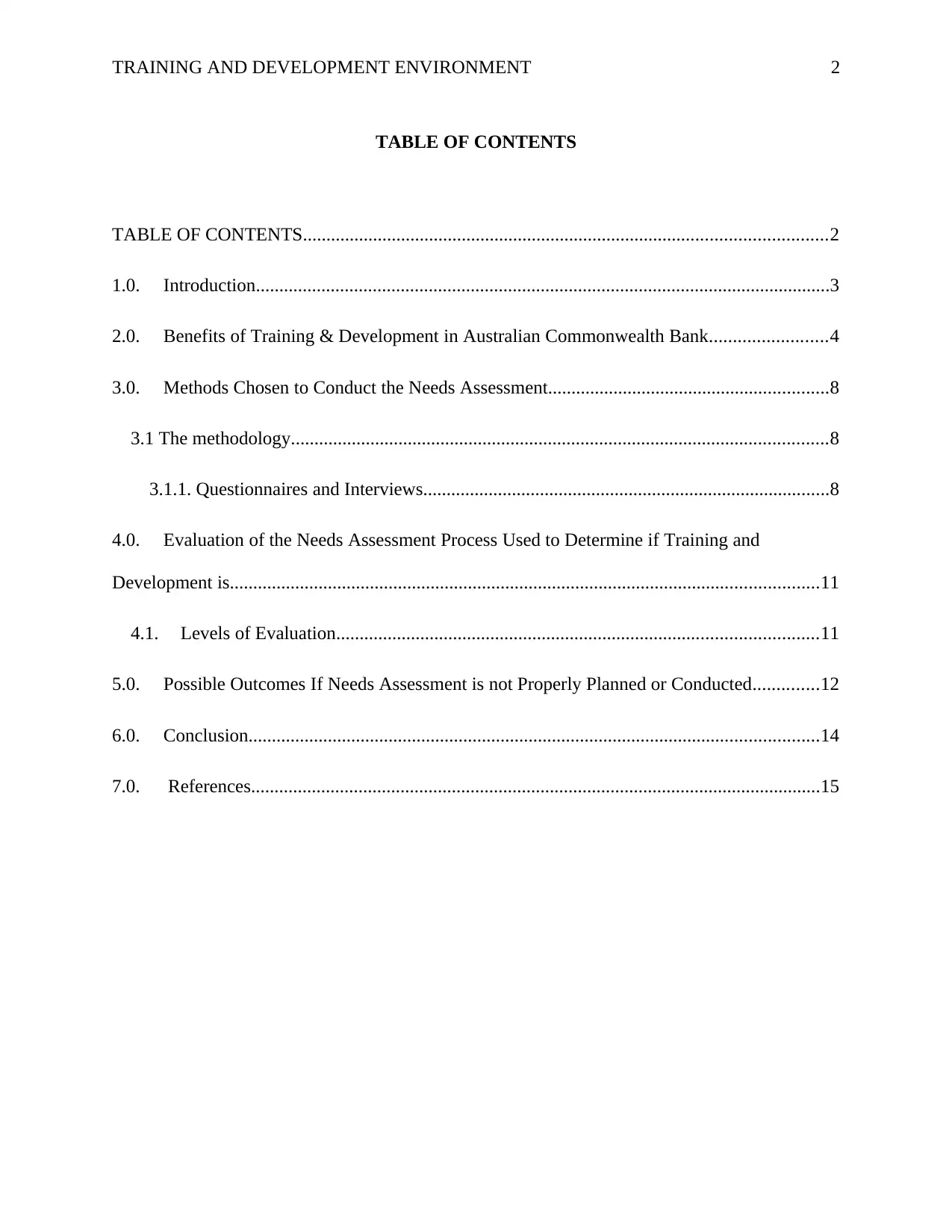
TRAINING AND DEVELOPMENT ENVIRONMENT 2
TABLE OF CONTENTS
TABLE OF CONTENTS................................................................................................................2
1.0. Introduction...........................................................................................................................3
2.0. Benefits of Training & Development in Australian Commonwealth Bank.........................4
3.0. Methods Chosen to Conduct the Needs Assessment............................................................8
3.1 The methodology...................................................................................................................8
3.1.1. Questionnaires and Interviews.......................................................................................8
4.0. Evaluation of the Needs Assessment Process Used to Determine if Training and
Development is..............................................................................................................................11
4.1. Levels of Evaluation.......................................................................................................11
5.0. Possible Outcomes If Needs Assessment is not Properly Planned or Conducted..............12
6.0. Conclusion..........................................................................................................................14
7.0. References..........................................................................................................................15
TABLE OF CONTENTS
TABLE OF CONTENTS................................................................................................................2
1.0. Introduction...........................................................................................................................3
2.0. Benefits of Training & Development in Australian Commonwealth Bank.........................4
3.0. Methods Chosen to Conduct the Needs Assessment............................................................8
3.1 The methodology...................................................................................................................8
3.1.1. Questionnaires and Interviews.......................................................................................8
4.0. Evaluation of the Needs Assessment Process Used to Determine if Training and
Development is..............................................................................................................................11
4.1. Levels of Evaluation.......................................................................................................11
5.0. Possible Outcomes If Needs Assessment is not Properly Planned or Conducted..............12
6.0. Conclusion..........................................................................................................................14
7.0. References..........................................................................................................................15
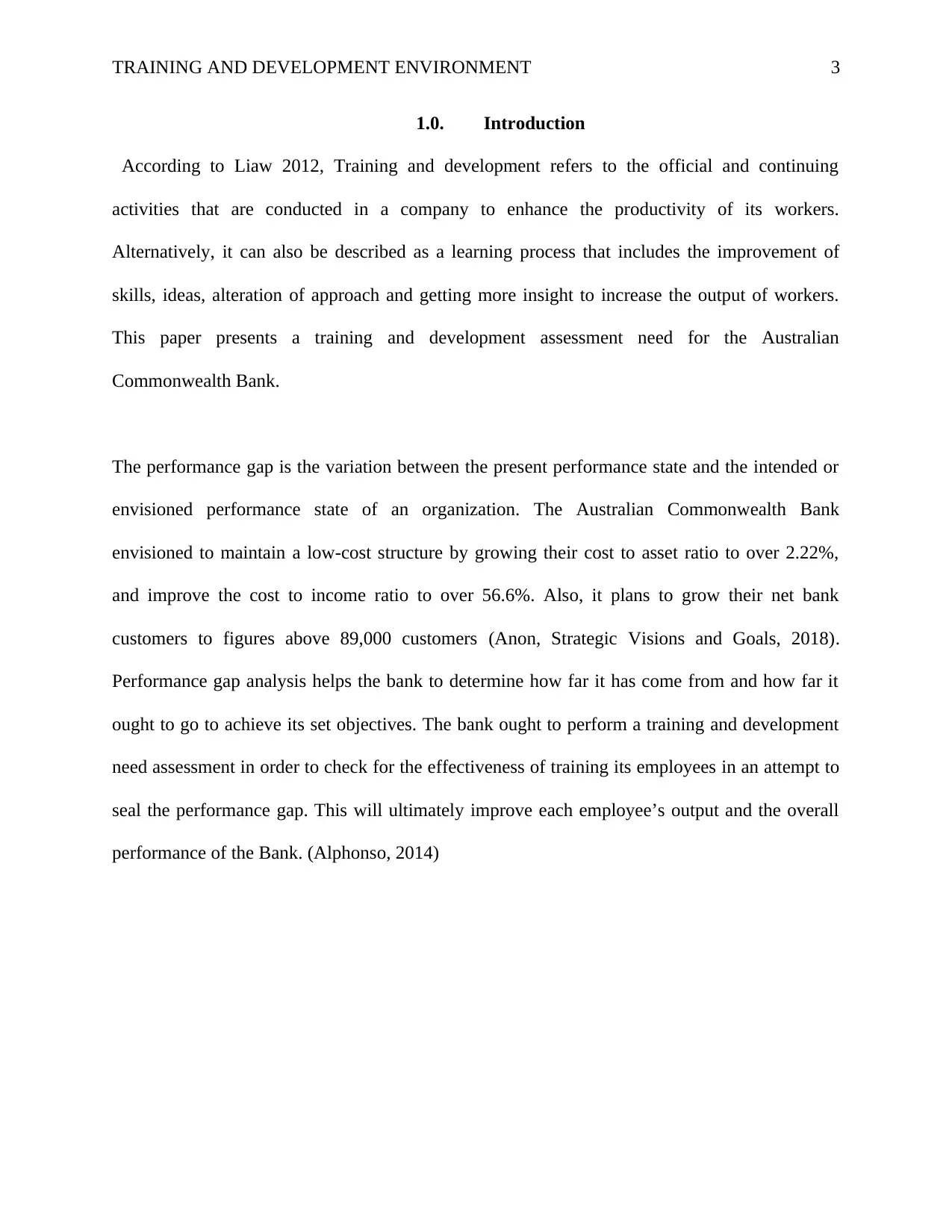
TRAINING AND DEVELOPMENT ENVIRONMENT 3
1.0. Introduction
According to Liaw 2012, Training and development refers to the official and continuing
activities that are conducted in a company to enhance the productivity of its workers.
Alternatively, it can also be described as a learning process that includes the improvement of
skills, ideas, alteration of approach and getting more insight to increase the output of workers.
This paper presents a training and development assessment need for the Australian
Commonwealth Bank.
The performance gap is the variation between the present performance state and the intended or
envisioned performance state of an organization. The Australian Commonwealth Bank
envisioned to maintain a low-cost structure by growing their cost to asset ratio to over 2.22%,
and improve the cost to income ratio to over 56.6%. Also, it plans to grow their net bank
customers to figures above 89,000 customers (Anon, Strategic Visions and Goals, 2018).
Performance gap analysis helps the bank to determine how far it has come from and how far it
ought to go to achieve its set objectives. The bank ought to perform a training and development
need assessment in order to check for the effectiveness of training its employees in an attempt to
seal the performance gap. This will ultimately improve each employee’s output and the overall
performance of the Bank. (Alphonso, 2014)
1.0. Introduction
According to Liaw 2012, Training and development refers to the official and continuing
activities that are conducted in a company to enhance the productivity of its workers.
Alternatively, it can also be described as a learning process that includes the improvement of
skills, ideas, alteration of approach and getting more insight to increase the output of workers.
This paper presents a training and development assessment need for the Australian
Commonwealth Bank.
The performance gap is the variation between the present performance state and the intended or
envisioned performance state of an organization. The Australian Commonwealth Bank
envisioned to maintain a low-cost structure by growing their cost to asset ratio to over 2.22%,
and improve the cost to income ratio to over 56.6%. Also, it plans to grow their net bank
customers to figures above 89,000 customers (Anon, Strategic Visions and Goals, 2018).
Performance gap analysis helps the bank to determine how far it has come from and how far it
ought to go to achieve its set objectives. The bank ought to perform a training and development
need assessment in order to check for the effectiveness of training its employees in an attempt to
seal the performance gap. This will ultimately improve each employee’s output and the overall
performance of the Bank. (Alphonso, 2014)
⊘ This is a preview!⊘
Do you want full access?
Subscribe today to unlock all pages.

Trusted by 1+ million students worldwide
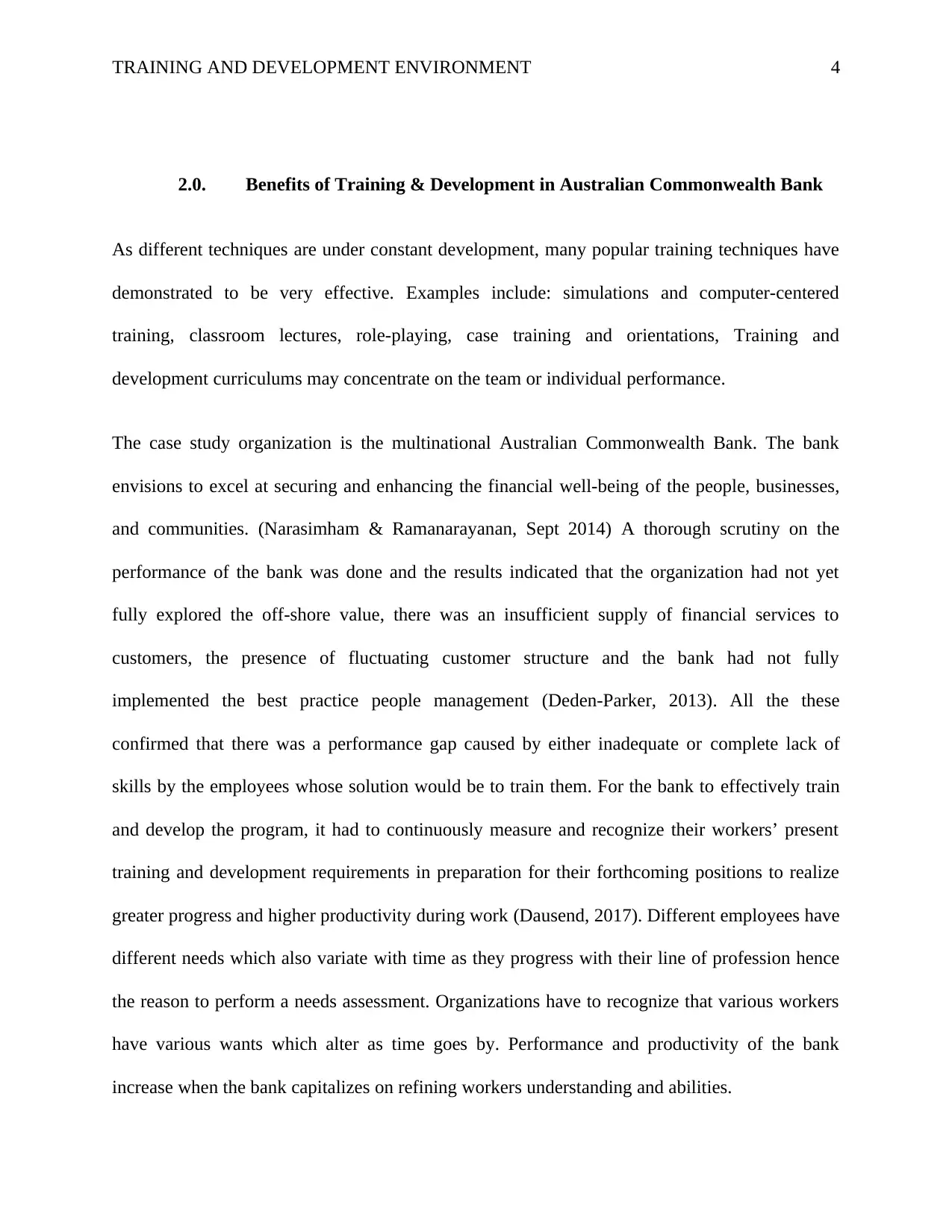
TRAINING AND DEVELOPMENT ENVIRONMENT 4
2.0. Benefits of Training & Development in Australian Commonwealth Bank
As different techniques are under constant development, many popular training techniques have
demonstrated to be very effective. Examples include: simulations and computer-centered
training, classroom lectures, role-playing, case training and orientations, Training and
development curriculums may concentrate on the team or individual performance.
The case study organization is the multinational Australian Commonwealth Bank. The bank
envisions to excel at securing and enhancing the financial well-being of the people, businesses,
and communities. (Narasimham & Ramanarayanan, Sept 2014) A thorough scrutiny on the
performance of the bank was done and the results indicated that the organization had not yet
fully explored the off-shore value, there was an insufficient supply of financial services to
customers, the presence of fluctuating customer structure and the bank had not fully
implemented the best practice people management (Deden-Parker, 2013). All the these
confirmed that there was a performance gap caused by either inadequate or complete lack of
skills by the employees whose solution would be to train them. For the bank to effectively train
and develop the program, it had to continuously measure and recognize their workers’ present
training and development requirements in preparation for their forthcoming positions to realize
greater progress and higher productivity during work (Dausend, 2017). Different employees have
different needs which also variate with time as they progress with their line of profession hence
the reason to perform a needs assessment. Organizations have to recognize that various workers
have various wants which alter as time goes by. Performance and productivity of the bank
increase when the bank capitalizes on refining workers understanding and abilities.
2.0. Benefits of Training & Development in Australian Commonwealth Bank
As different techniques are under constant development, many popular training techniques have
demonstrated to be very effective. Examples include: simulations and computer-centered
training, classroom lectures, role-playing, case training and orientations, Training and
development curriculums may concentrate on the team or individual performance.
The case study organization is the multinational Australian Commonwealth Bank. The bank
envisions to excel at securing and enhancing the financial well-being of the people, businesses,
and communities. (Narasimham & Ramanarayanan, Sept 2014) A thorough scrutiny on the
performance of the bank was done and the results indicated that the organization had not yet
fully explored the off-shore value, there was an insufficient supply of financial services to
customers, the presence of fluctuating customer structure and the bank had not fully
implemented the best practice people management (Deden-Parker, 2013). All the these
confirmed that there was a performance gap caused by either inadequate or complete lack of
skills by the employees whose solution would be to train them. For the bank to effectively train
and develop the program, it had to continuously measure and recognize their workers’ present
training and development requirements in preparation for their forthcoming positions to realize
greater progress and higher productivity during work (Dausend, 2017). Different employees have
different needs which also variate with time as they progress with their line of profession hence
the reason to perform a needs assessment. Organizations have to recognize that various workers
have various wants which alter as time goes by. Performance and productivity of the bank
increase when the bank capitalizes on refining workers understanding and abilities.
Paraphrase This Document
Need a fresh take? Get an instant paraphrase of this document with our AI Paraphraser
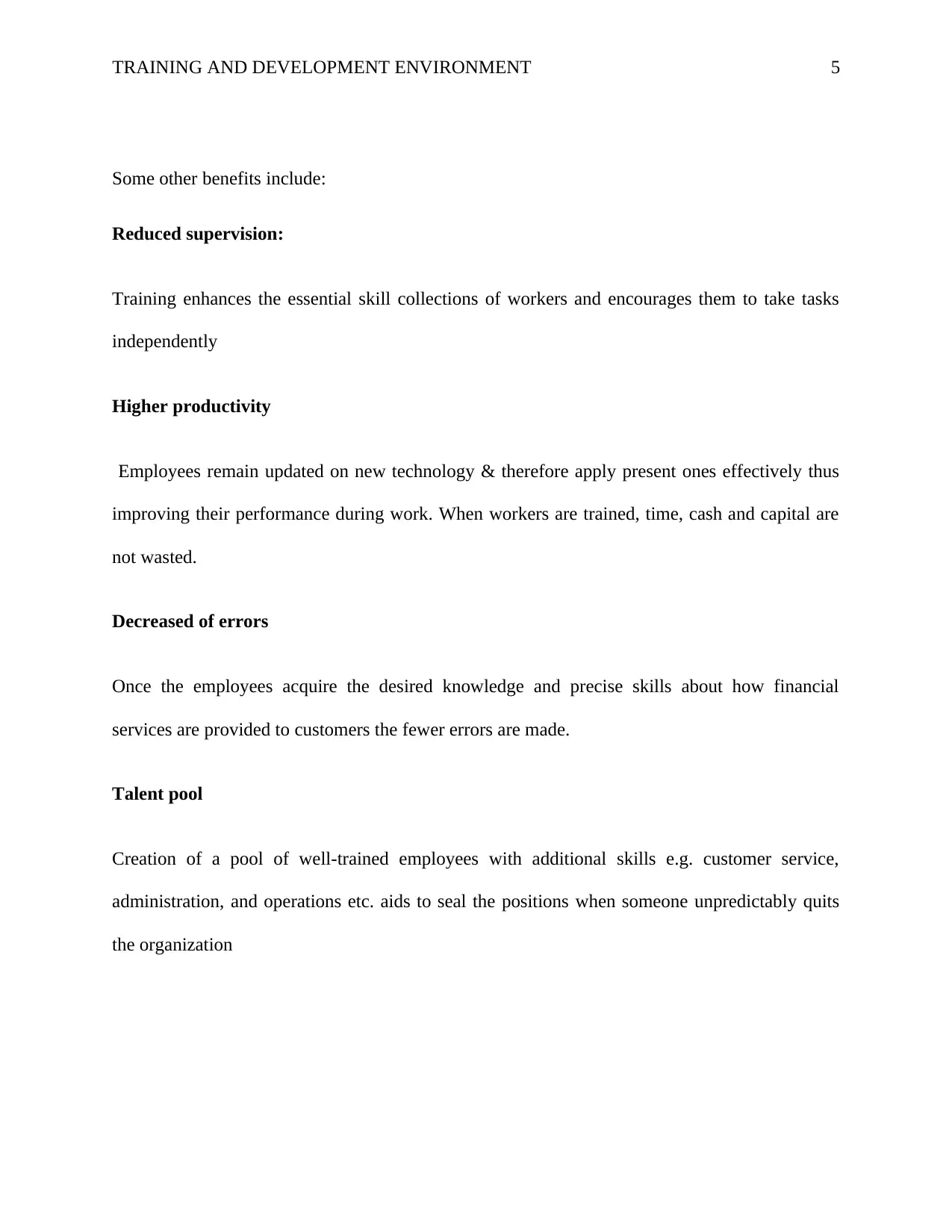
TRAINING AND DEVELOPMENT ENVIRONMENT 5
Some other benefits include:
Reduced supervision:
Training enhances the essential skill collections of workers and encourages them to take tasks
independently
Higher productivity
Employees remain updated on new technology & therefore apply present ones effectively thus
improving their performance during work. When workers are trained, time, cash and capital are
not wasted.
Decreased of errors
Once the employees acquire the desired knowledge and precise skills about how financial
services are provided to customers the fewer errors are made.
Talent pool
Creation of a pool of well-trained employees with additional skills e.g. customer service,
administration, and operations etc. aids to seal the positions when someone unpredictably quits
the organization
Some other benefits include:
Reduced supervision:
Training enhances the essential skill collections of workers and encourages them to take tasks
independently
Higher productivity
Employees remain updated on new technology & therefore apply present ones effectively thus
improving their performance during work. When workers are trained, time, cash and capital are
not wasted.
Decreased of errors
Once the employees acquire the desired knowledge and precise skills about how financial
services are provided to customers the fewer errors are made.
Talent pool
Creation of a pool of well-trained employees with additional skills e.g. customer service,
administration, and operations etc. aids to seal the positions when someone unpredictably quits
the organization
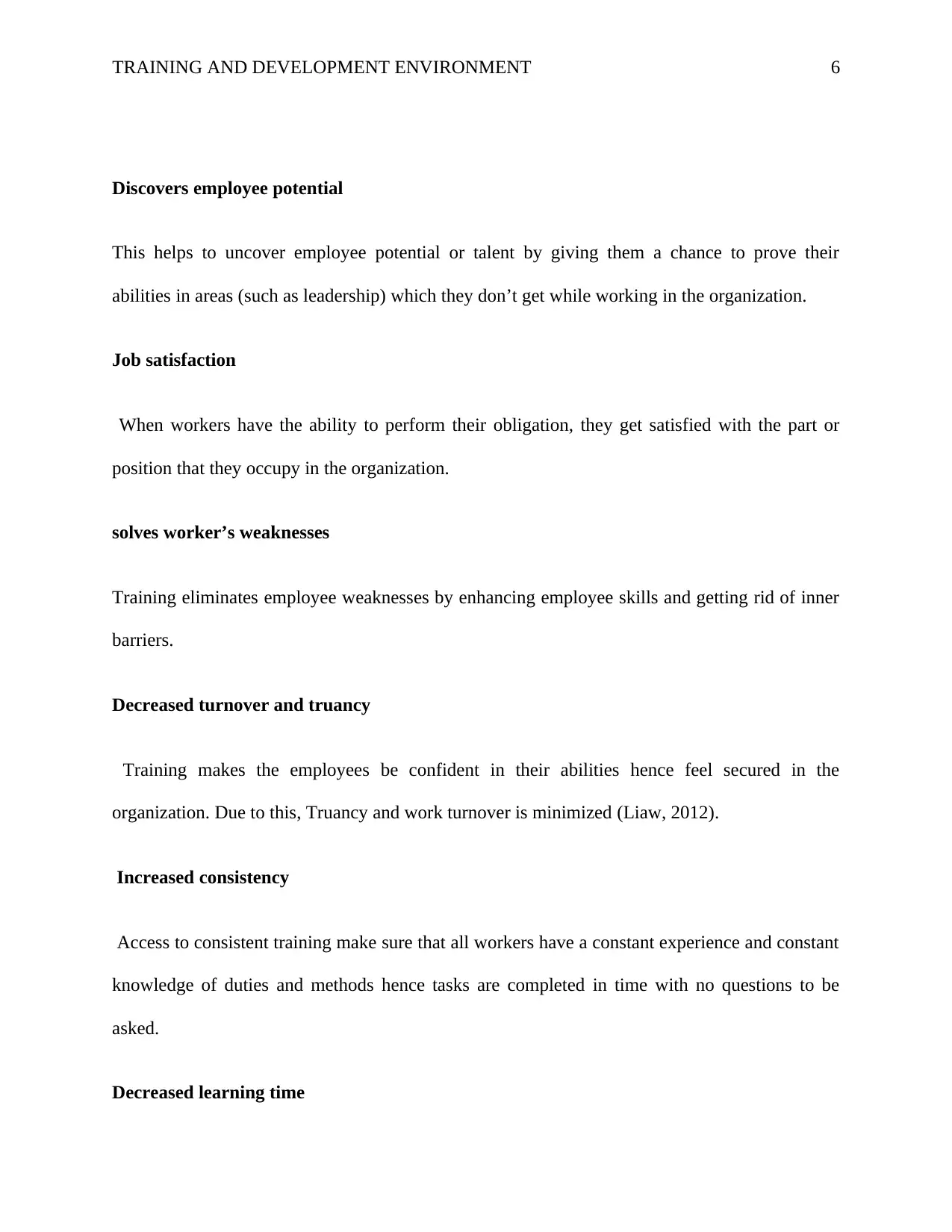
TRAINING AND DEVELOPMENT ENVIRONMENT 6
Discovers employee potential
This helps to uncover employee potential or talent by giving them a chance to prove their
abilities in areas (such as leadership) which they don’t get while working in the organization.
Job satisfaction
When workers have the ability to perform their obligation, they get satisfied with the part or
position that they occupy in the organization.
solves worker’s weaknesses
Training eliminates employee weaknesses by enhancing employee skills and getting rid of inner
barriers.
Decreased turnover and truancy
Training makes the employees be confident in their abilities hence feel secured in the
organization. Due to this, Truancy and work turnover is minimized (Liaw, 2012).
Increased consistency
Access to consistent training make sure that all workers have a constant experience and constant
knowledge of duties and methods hence tasks are completed in time with no questions to be
asked.
Decreased learning time
Discovers employee potential
This helps to uncover employee potential or talent by giving them a chance to prove their
abilities in areas (such as leadership) which they don’t get while working in the organization.
Job satisfaction
When workers have the ability to perform their obligation, they get satisfied with the part or
position that they occupy in the organization.
solves worker’s weaknesses
Training eliminates employee weaknesses by enhancing employee skills and getting rid of inner
barriers.
Decreased turnover and truancy
Training makes the employees be confident in their abilities hence feel secured in the
organization. Due to this, Truancy and work turnover is minimized (Liaw, 2012).
Increased consistency
Access to consistent training make sure that all workers have a constant experience and constant
knowledge of duties and methods hence tasks are completed in time with no questions to be
asked.
Decreased learning time
⊘ This is a preview!⊘
Do you want full access?
Subscribe today to unlock all pages.

Trusted by 1+ million students worldwide
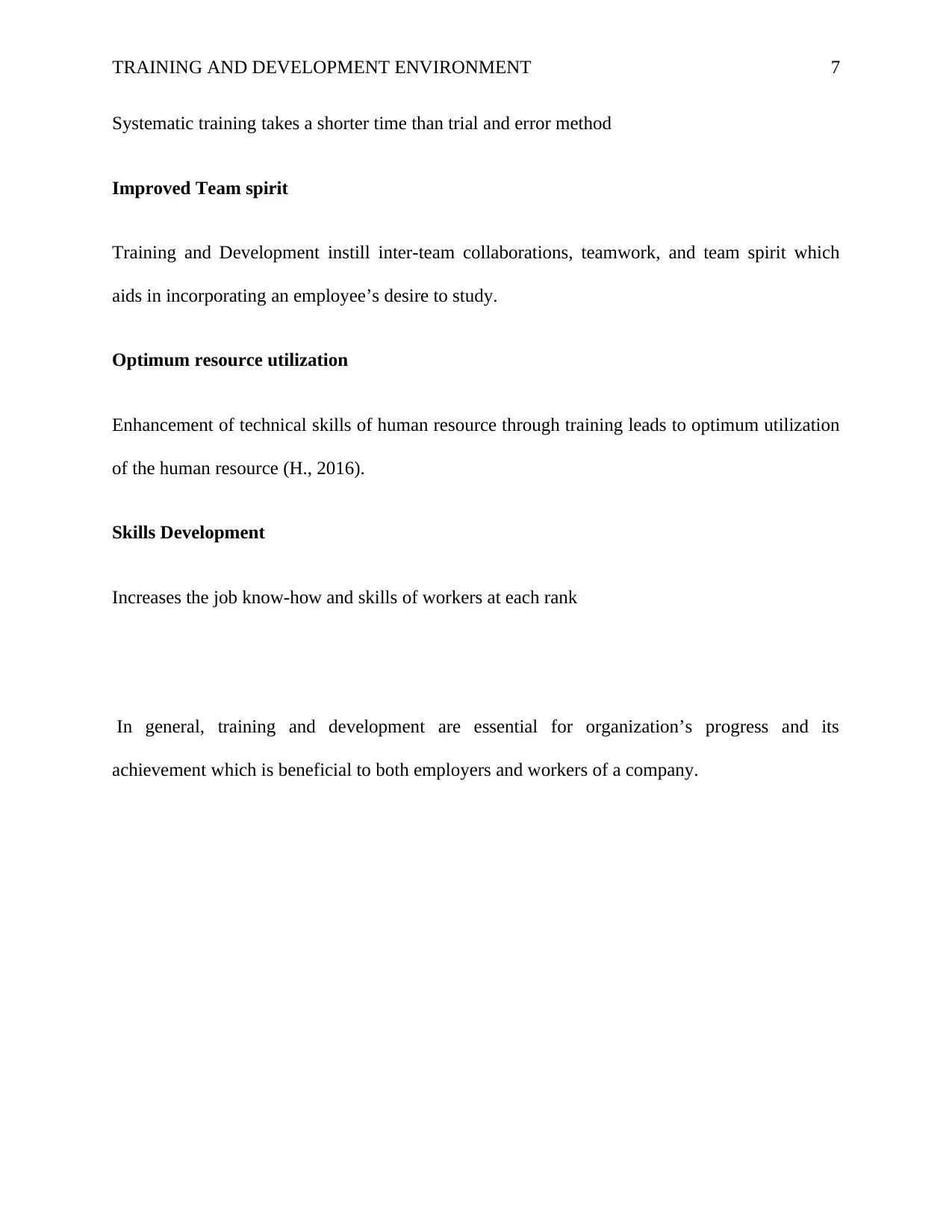
TRAINING AND DEVELOPMENT ENVIRONMENT 7
Systematic training takes a shorter time than trial and error method
Improved Team spirit
Training and Development instill inter-team collaborations, teamwork, and team spirit which
aids in incorporating an employee’s desire to study.
Optimum resource utilization
Enhancement of technical skills of human resource through training leads to optimum utilization
of the human resource (H., 2016).
Skills Development
Increases the job know-how and skills of workers at each rank
In general, training and development are essential for organization’s progress and its
achievement which is beneficial to both employers and workers of a company.
Systematic training takes a shorter time than trial and error method
Improved Team spirit
Training and Development instill inter-team collaborations, teamwork, and team spirit which
aids in incorporating an employee’s desire to study.
Optimum resource utilization
Enhancement of technical skills of human resource through training leads to optimum utilization
of the human resource (H., 2016).
Skills Development
Increases the job know-how and skills of workers at each rank
In general, training and development are essential for organization’s progress and its
achievement which is beneficial to both employers and workers of a company.
Paraphrase This Document
Need a fresh take? Get an instant paraphrase of this document with our AI Paraphraser
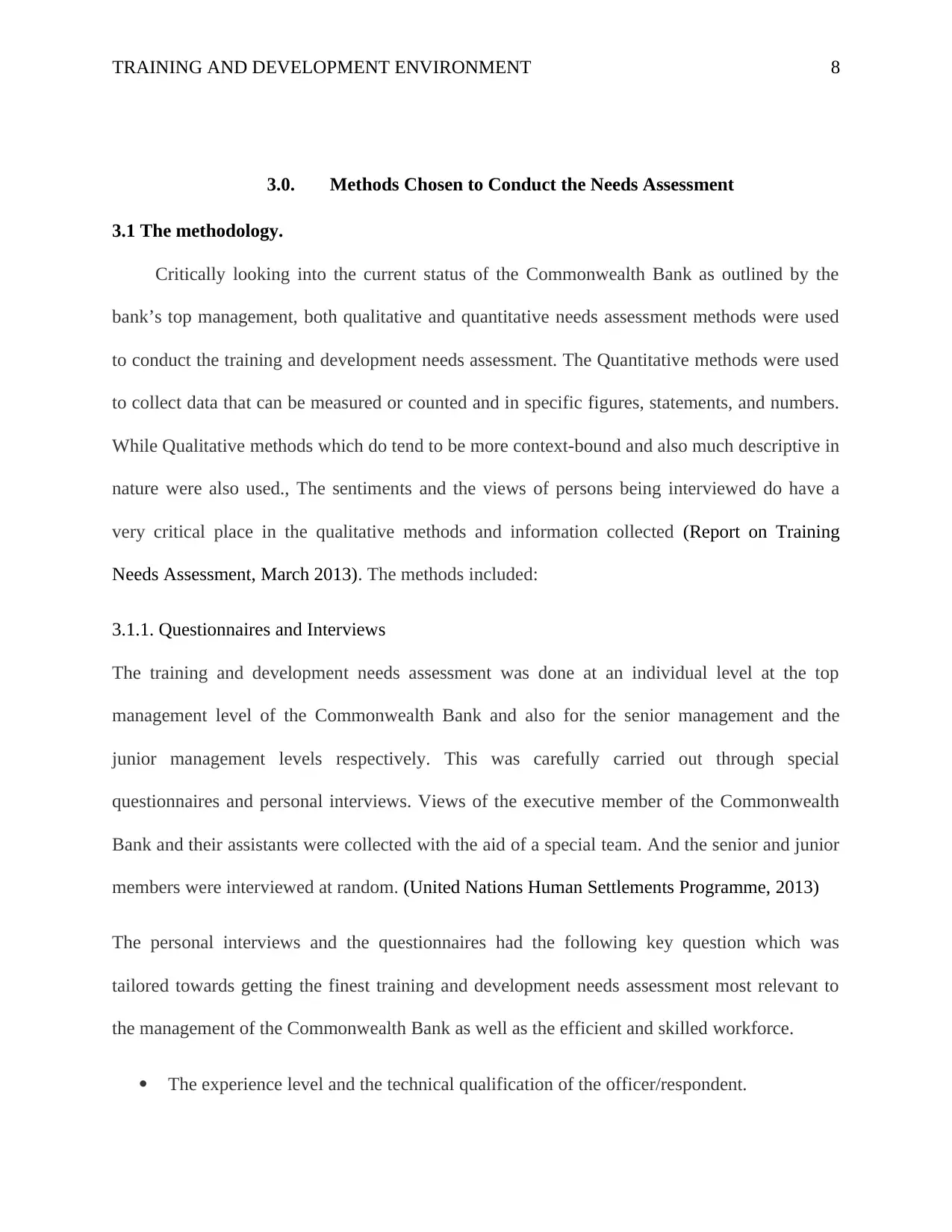
TRAINING AND DEVELOPMENT ENVIRONMENT 8
3.0. Methods Chosen to Conduct the Needs Assessment
3.1 The methodology.
Critically looking into the current status of the Commonwealth Bank as outlined by the
bank’s top management, both qualitative and quantitative needs assessment methods were used
to conduct the training and development needs assessment. The Quantitative methods were used
to collect data that can be measured or counted and in specific figures, statements, and numbers.
While Qualitative methods which do tend to be more context-bound and also much descriptive in
nature were also used., The sentiments and the views of persons being interviewed do have a
very critical place in the qualitative methods and information collected (Report on Training
Needs Assessment, March 2013). The methods included:
3.1.1. Questionnaires and Interviews
The training and development needs assessment was done at an individual level at the top
management level of the Commonwealth Bank and also for the senior management and the
junior management levels respectively. This was carefully carried out through special
questionnaires and personal interviews. Views of the executive member of the Commonwealth
Bank and their assistants were collected with the aid of a special team. And the senior and junior
members were interviewed at random. (United Nations Human Settlements Programme, 2013)
The personal interviews and the questionnaires had the following key question which was
tailored towards getting the finest training and development needs assessment most relevant to
the management of the Commonwealth Bank as well as the efficient and skilled workforce.
The experience level and the technical qualification of the officer/respondent.
3.0. Methods Chosen to Conduct the Needs Assessment
3.1 The methodology.
Critically looking into the current status of the Commonwealth Bank as outlined by the
bank’s top management, both qualitative and quantitative needs assessment methods were used
to conduct the training and development needs assessment. The Quantitative methods were used
to collect data that can be measured or counted and in specific figures, statements, and numbers.
While Qualitative methods which do tend to be more context-bound and also much descriptive in
nature were also used., The sentiments and the views of persons being interviewed do have a
very critical place in the qualitative methods and information collected (Report on Training
Needs Assessment, March 2013). The methods included:
3.1.1. Questionnaires and Interviews
The training and development needs assessment was done at an individual level at the top
management level of the Commonwealth Bank and also for the senior management and the
junior management levels respectively. This was carefully carried out through special
questionnaires and personal interviews. Views of the executive member of the Commonwealth
Bank and their assistants were collected with the aid of a special team. And the senior and junior
members were interviewed at random. (United Nations Human Settlements Programme, 2013)
The personal interviews and the questionnaires had the following key question which was
tailored towards getting the finest training and development needs assessment most relevant to
the management of the Commonwealth Bank as well as the efficient and skilled workforce.
The experience level and the technical qualification of the officer/respondent.
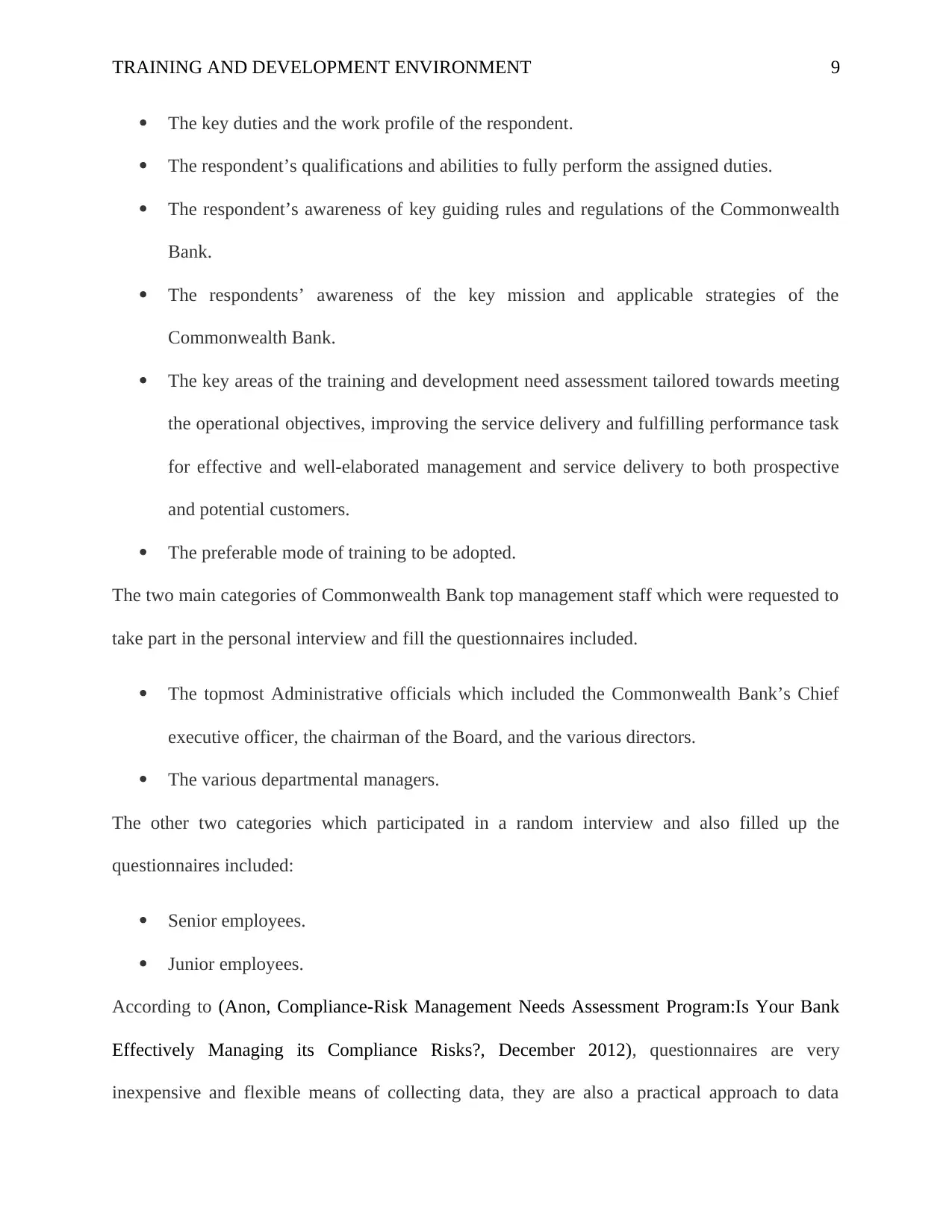
TRAINING AND DEVELOPMENT ENVIRONMENT 9
The key duties and the work profile of the respondent.
The respondent’s qualifications and abilities to fully perform the assigned duties.
The respondent’s awareness of key guiding rules and regulations of the Commonwealth
Bank.
The respondents’ awareness of the key mission and applicable strategies of the
Commonwealth Bank.
The key areas of the training and development need assessment tailored towards meeting
the operational objectives, improving the service delivery and fulfilling performance task
for effective and well-elaborated management and service delivery to both prospective
and potential customers.
The preferable mode of training to be adopted.
The two main categories of Commonwealth Bank top management staff which were requested to
take part in the personal interview and fill the questionnaires included.
The topmost Administrative officials which included the Commonwealth Bank’s Chief
executive officer, the chairman of the Board, and the various directors.
The various departmental managers.
The other two categories which participated in a random interview and also filled up the
questionnaires included:
Senior employees.
Junior employees.
According to (Anon, Compliance-Risk Management Needs Assessment Program:Is Your Bank
Effectively Managing its Compliance Risks?, December 2012), questionnaires are very
inexpensive and flexible means of collecting data, they are also a practical approach to data
The key duties and the work profile of the respondent.
The respondent’s qualifications and abilities to fully perform the assigned duties.
The respondent’s awareness of key guiding rules and regulations of the Commonwealth
Bank.
The respondents’ awareness of the key mission and applicable strategies of the
Commonwealth Bank.
The key areas of the training and development need assessment tailored towards meeting
the operational objectives, improving the service delivery and fulfilling performance task
for effective and well-elaborated management and service delivery to both prospective
and potential customers.
The preferable mode of training to be adopted.
The two main categories of Commonwealth Bank top management staff which were requested to
take part in the personal interview and fill the questionnaires included.
The topmost Administrative officials which included the Commonwealth Bank’s Chief
executive officer, the chairman of the Board, and the various directors.
The various departmental managers.
The other two categories which participated in a random interview and also filled up the
questionnaires included:
Senior employees.
Junior employees.
According to (Anon, Compliance-Risk Management Needs Assessment Program:Is Your Bank
Effectively Managing its Compliance Risks?, December 2012), questionnaires are very
inexpensive and flexible means of collecting data, they are also a practical approach to data
⊘ This is a preview!⊘
Do you want full access?
Subscribe today to unlock all pages.

Trusted by 1+ million students worldwide
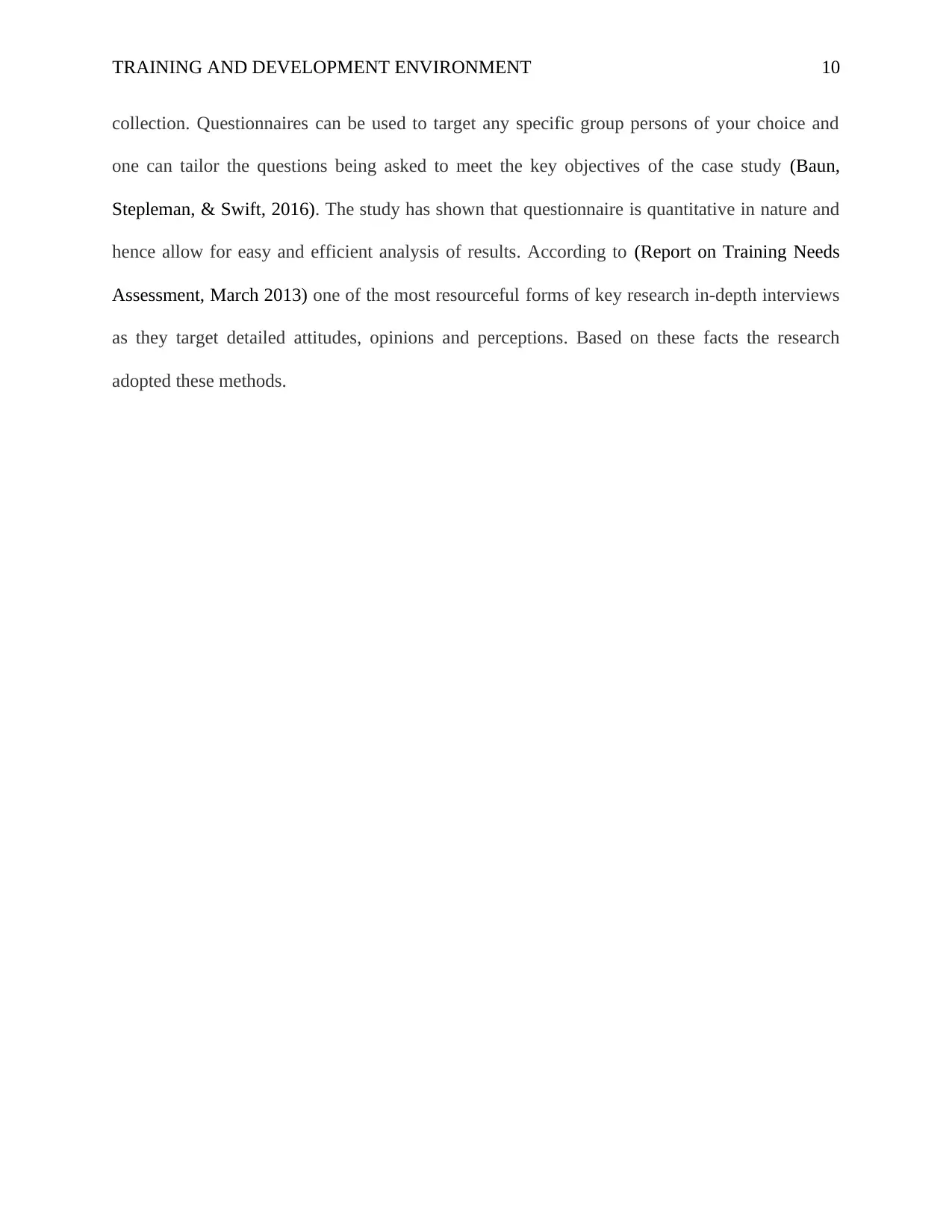
TRAINING AND DEVELOPMENT ENVIRONMENT 10
collection. Questionnaires can be used to target any specific group persons of your choice and
one can tailor the questions being asked to meet the key objectives of the case study (Baun,
Stepleman, & Swift, 2016). The study has shown that questionnaire is quantitative in nature and
hence allow for easy and efficient analysis of results. According to (Report on Training Needs
Assessment, March 2013) one of the most resourceful forms of key research in-depth interviews
as they target detailed attitudes, opinions and perceptions. Based on these facts the research
adopted these methods.
collection. Questionnaires can be used to target any specific group persons of your choice and
one can tailor the questions being asked to meet the key objectives of the case study (Baun,
Stepleman, & Swift, 2016). The study has shown that questionnaire is quantitative in nature and
hence allow for easy and efficient analysis of results. According to (Report on Training Needs
Assessment, March 2013) one of the most resourceful forms of key research in-depth interviews
as they target detailed attitudes, opinions and perceptions. Based on these facts the research
adopted these methods.
Paraphrase This Document
Need a fresh take? Get an instant paraphrase of this document with our AI Paraphraser
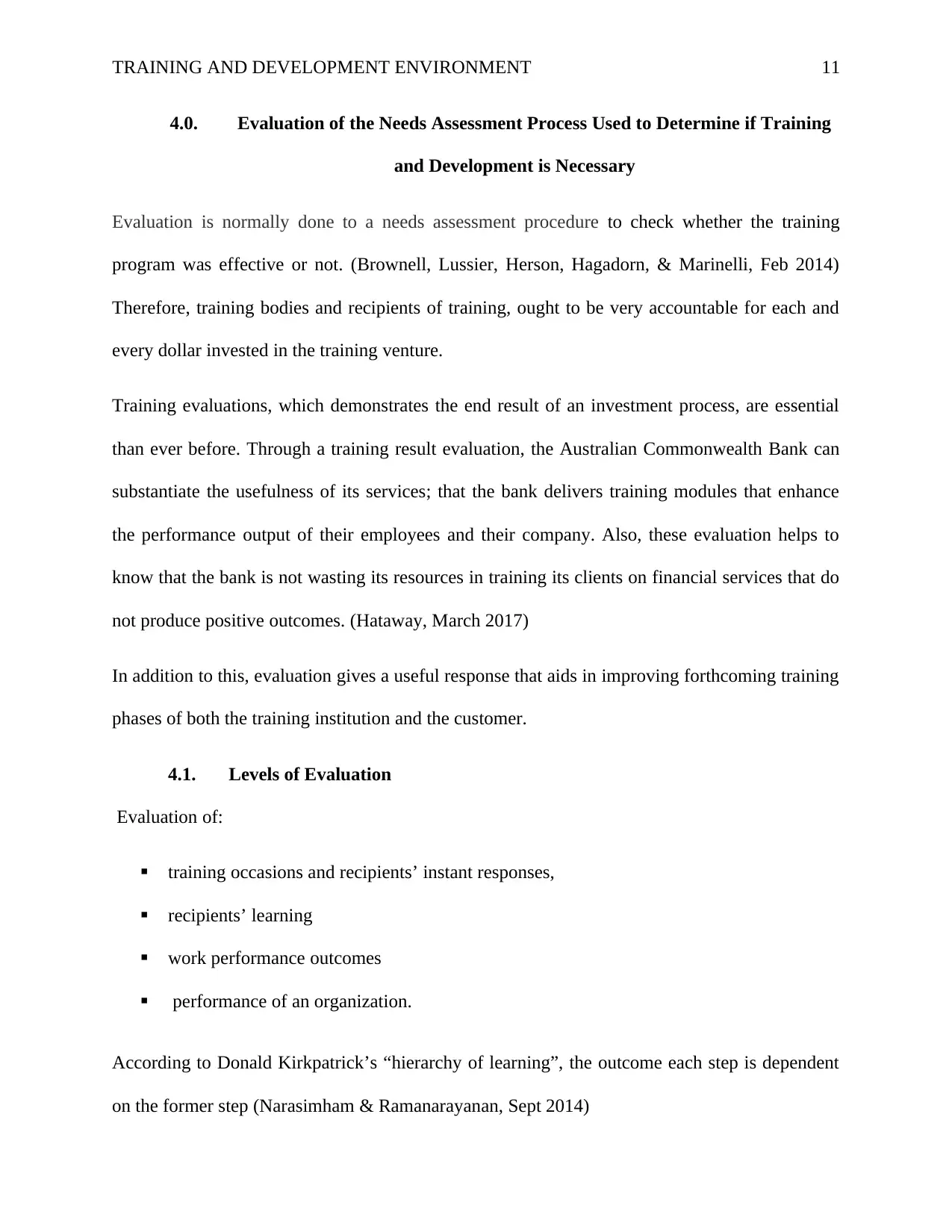
TRAINING AND DEVELOPMENT ENVIRONMENT 11
4.0. Evaluation of the Needs Assessment Process Used to Determine if Training
and Development is Necessary
Evaluation is normally done to a needs assessment procedure to check whether the training
program was effective or not. (Brownell, Lussier, Herson, Hagadorn, & Marinelli, Feb 2014)
Therefore, training bodies and recipients of training, ought to be very accountable for each and
every dollar invested in the training venture.
Training evaluations, which demonstrates the end result of an investment process, are essential
than ever before. Through a training result evaluation, the Australian Commonwealth Bank can
substantiate the usefulness of its services; that the bank delivers training modules that enhance
the performance output of their employees and their company. Also, these evaluation helps to
know that the bank is not wasting its resources in training its clients on financial services that do
not produce positive outcomes. (Hataway, March 2017)
In addition to this, evaluation gives a useful response that aids in improving forthcoming training
phases of both the training institution and the customer.
4.1. Levels of Evaluation
Evaluation of:
training occasions and recipients’ instant responses,
recipients’ learning
work performance outcomes
performance of an organization.
According to Donald Kirkpatrick’s “hierarchy of learning”, the outcome each step is dependent
on the former step (Narasimham & Ramanarayanan, Sept 2014)
4.0. Evaluation of the Needs Assessment Process Used to Determine if Training
and Development is Necessary
Evaluation is normally done to a needs assessment procedure to check whether the training
program was effective or not. (Brownell, Lussier, Herson, Hagadorn, & Marinelli, Feb 2014)
Therefore, training bodies and recipients of training, ought to be very accountable for each and
every dollar invested in the training venture.
Training evaluations, which demonstrates the end result of an investment process, are essential
than ever before. Through a training result evaluation, the Australian Commonwealth Bank can
substantiate the usefulness of its services; that the bank delivers training modules that enhance
the performance output of their employees and their company. Also, these evaluation helps to
know that the bank is not wasting its resources in training its clients on financial services that do
not produce positive outcomes. (Hataway, March 2017)
In addition to this, evaluation gives a useful response that aids in improving forthcoming training
phases of both the training institution and the customer.
4.1. Levels of Evaluation
Evaluation of:
training occasions and recipients’ instant responses,
recipients’ learning
work performance outcomes
performance of an organization.
According to Donald Kirkpatrick’s “hierarchy of learning”, the outcome each step is dependent
on the former step (Narasimham & Ramanarayanan, Sept 2014)
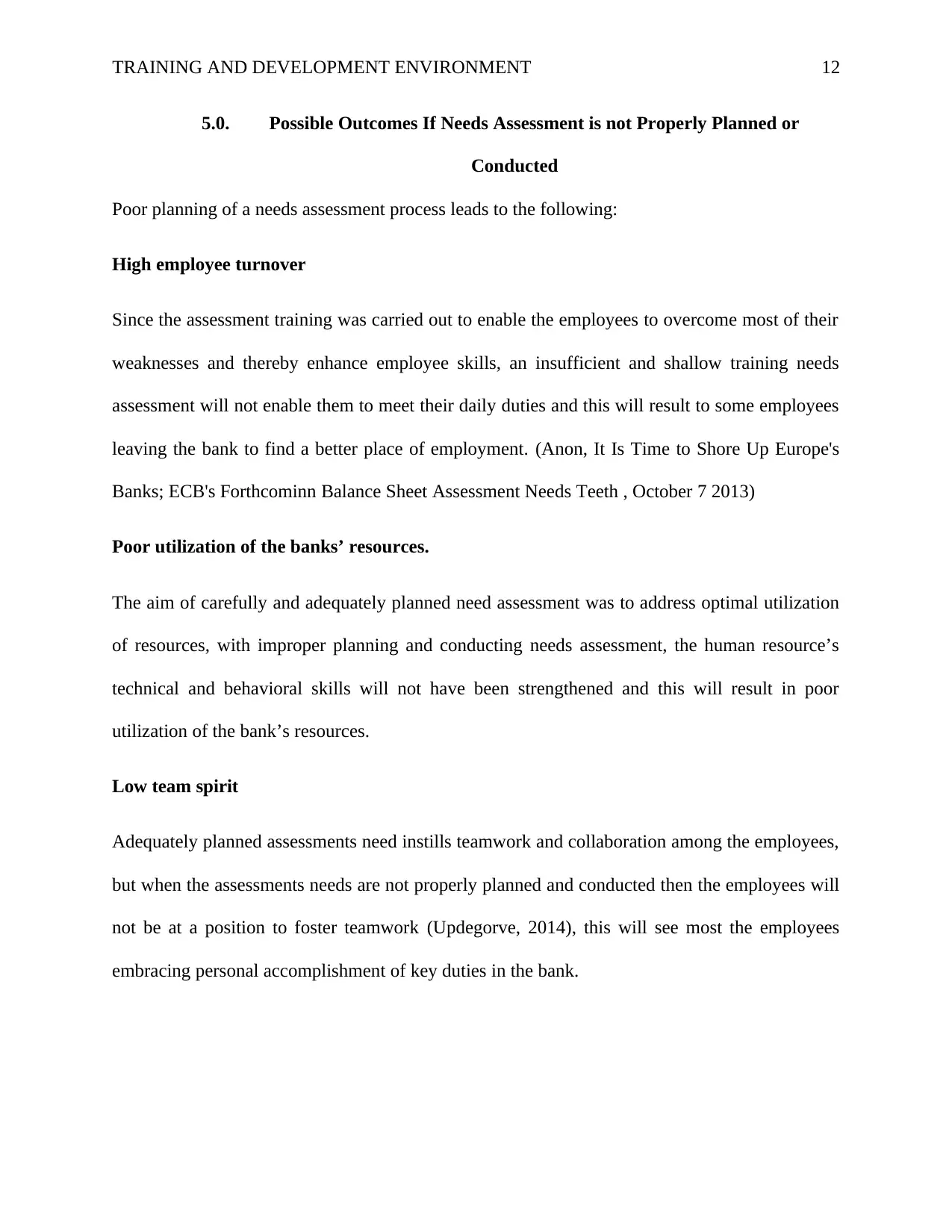
TRAINING AND DEVELOPMENT ENVIRONMENT 12
5.0. Possible Outcomes If Needs Assessment is not Properly Planned or
Conducted
Poor planning of a needs assessment process leads to the following:
High employee turnover
Since the assessment training was carried out to enable the employees to overcome most of their
weaknesses and thereby enhance employee skills, an insufficient and shallow training needs
assessment will not enable them to meet their daily duties and this will result to some employees
leaving the bank to find a better place of employment. (Anon, It Is Time to Shore Up Europe's
Banks; ECB's Forthcominn Balance Sheet Assessment Needs Teeth , October 7 2013)
Poor utilization of the banks’ resources.
The aim of carefully and adequately planned need assessment was to address optimal utilization
of resources, with improper planning and conducting needs assessment, the human resource’s
technical and behavioral skills will not have been strengthened and this will result in poor
utilization of the bank’s resources.
Low team spirit
Adequately planned assessments need instills teamwork and collaboration among the employees,
but when the assessments needs are not properly planned and conducted then the employees will
not be at a position to foster teamwork (Updegorve, 2014), this will see most the employees
embracing personal accomplishment of key duties in the bank.
5.0. Possible Outcomes If Needs Assessment is not Properly Planned or
Conducted
Poor planning of a needs assessment process leads to the following:
High employee turnover
Since the assessment training was carried out to enable the employees to overcome most of their
weaknesses and thereby enhance employee skills, an insufficient and shallow training needs
assessment will not enable them to meet their daily duties and this will result to some employees
leaving the bank to find a better place of employment. (Anon, It Is Time to Shore Up Europe's
Banks; ECB's Forthcominn Balance Sheet Assessment Needs Teeth , October 7 2013)
Poor utilization of the banks’ resources.
The aim of carefully and adequately planned need assessment was to address optimal utilization
of resources, with improper planning and conducting needs assessment, the human resource’s
technical and behavioral skills will not have been strengthened and this will result in poor
utilization of the bank’s resources.
Low team spirit
Adequately planned assessments need instills teamwork and collaboration among the employees,
but when the assessments needs are not properly planned and conducted then the employees will
not be at a position to foster teamwork (Updegorve, 2014), this will see most the employees
embracing personal accomplishment of key duties in the bank.
⊘ This is a preview!⊘
Do you want full access?
Subscribe today to unlock all pages.

Trusted by 1+ million students worldwide
1 out of 17
Related Documents
Your All-in-One AI-Powered Toolkit for Academic Success.
+13062052269
info@desklib.com
Available 24*7 on WhatsApp / Email
![[object Object]](/_next/static/media/star-bottom.7253800d.svg)
Unlock your academic potential
Copyright © 2020–2025 A2Z Services. All Rights Reserved. Developed and managed by ZUCOL.





